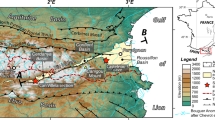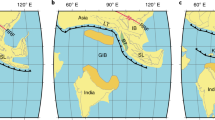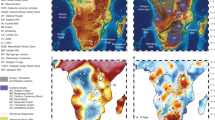Abstract
The elevation history of the Tibetan plateau provides direct insight into the tectonic processes associated with continent–continent collisions. Here we present oxygen-isotope-based estimates of the palaeo-altimetry of late Eocene and younger deposits of the Lunpola basin in the centre of the plateau, which indicate that the surface of Tibet has been at an elevation of more than 4 kilometres for at least the past 35 million years. We conclude that crustal, but not mantle, thickening models, combined with plate-kinematic solutions of India–Asia convergence, are compatible with palaeo-elevation estimates across the Tibetan plateau.
This is a preview of subscription content, access via your institution
Access options
Subscribe to this journal
Receive 51 print issues and online access
$199.00 per year
only $3.90 per issue
Buy this article
- Purchase on Springer Link
- Instant access to full article PDF
Prices may be subject to local taxes which are calculated during checkout




Similar content being viewed by others
References
Argand, E. La tectonique de l'Asie. In Proc. 13th Int. Geological Congress Vol. 1, Part 5, 171–372 (Vaillant-Carmanne, Liège, 1924)
Dewey, J. F. & Burke, K. C. A. Tibetan, Variscan, and Precambrian basement reactivation: products of continental collision. J. Geol. 81, 683–692 (1973)
Beaumont, C., Jamieson, R. A., Nguyen, M. H. & Medvedev, S. Crustal channel flows: 1. Numerical models with applications to the tectonics of the Himalayan–Tibetan orogen. J. Geophys. Res. 109, B06406, doi:10:1029/2003JB002809 (2004)
England, P. & Housemann, G. Finite strain calculations of continental deformation. II: Application to the India–Asia plate collision. J. Geophys. Res. 91, 3664–3676 (1986)
Houseman, G. & England, P. in The Tectonic Evolution of Asia (eds Yin, A. & Harrison, T. M.) 3–17 (Cambridge Univ. Press, Cambridge, 1996)
Molnar, P., England, P. & Martinod, J. Mantle dynamics, uplift of the Tibetan plateau, and the Indian Monsoon. Rev. Geophys. 31, 357–396 (1993)
Tapponnier, P., Peltzer, G., LeDain, A. Y., Armijo, R. & Cobbold, P. Propagating extrusion tectonics in Asia: new insights from simple experiments with plasticine. Geology 10, 611–616 (1982)
Tapponnier, P. et al. Oblique stepwise rise and growth of the Tibet plateau. Science 294, 1671–1677 (2001)
Royden, L. H. et al. Surface deformation and lower crustal flow in eastern Tibet. Science 276, 788–790 (1997)
Bureau of Geology and Mineral Resources Xizang Autonomous Region. Regional Geology of Xizang (Tibet) Autonomous Region (Geological Publishing House, Beijing, 1993)
Zhai, G. et al. (eds) Oil and gas fields in Qinghai and Xizang. In Petroleum Geology of China Vol. 14 (Petroleum Industry Press, Beijing, 1990)
Xia, J. B. Cenozoic of Baingoin and its borders, Xizang (Tibet) [Chinese with English summary]. Contrib. Geol. Qinghai-Xizang (Tibet) Plateau 3, 243–254 (1983)
Xu, Z. Y. The Tertiary and its petroleum potential in the Lunpola Basin, Tibet. Oil Gas Geol. 1, 153–158 (1980)
Xu, Z. Y., Zhao, J. P. & Wu, Z. L. On the Tertiary continental basins and their petroleum potential in Qinghai-Xizang (Tibet) Plateau with Lunpola Basin as example [Chinese with English summary]. Contrib. Geol. Qinghai-Xizang (Tibet) Plateau 17, 391–399 (1985)
Rowley, D. B., Pierrehumbert, R. T. & Currie, B. S. A new approach to stable isotope-based paleoaltimetry: Implications for paleoaltimetry and paleohypsometry of the High Himalaya since the Late Miocene. Earth Planet. Sci. Lett. 188, 253–268 (2001)
Garzione, C. N., Dettman, D. L., Quade, J., DeCelles, P. G. & Butler, R. F. High times on the Tibetan Plateau: Paleoelevation of the Thakkhola graben, Nepal. Geology 28, 339–342 (2000)
Garzione, C. N., Quade, J., DeCelles, P. G. & English, N. B. Predicting paleoelevation of Tibet and the Himalaya from δ18O vs. altitude gradients in meteoric water across the Nepal Himalaya. Earth Planet. Sci. Lett. 183, 215–229 (2000)
Currie, B. S., Rowley, D. B. & Tabor, N. J. Middle Miocene paleoaltimetry of southern Tibet: Implications for the role of mantle thickening and delamination in the Himalayan orogen. Geology 33, 181–184 (2005)
Dansgaard, W. Stable isotopes in precipitation. Tellus 16, 436–468 (1964)
Rozanski, K., Araguas-Araguas, L. & Gonfianti, R. in Climate Change in Continental Isotopic Records 1–36 (American Geophysical Union, Washington, 1993)
Tian, L., Masson-Delmotte, V., Stievenard, M., Yao, T. & Jouzel, J. Tibetan Plateau summer monsoon northward extent revealed by measurements of water stable isotopes. J. Geophys. Res. 106, 28081–28088 (2001)
IAEA. http://isohis.iaea.org/userupdate/GNIP2001yearly.xls (2001).
Garzione, C. N., Dettman, D. L. & Horton, B. K. Carbonate oxygen isotope paleoaltimetry: Evaluating the effect of diagenesis on paleoelevation estimates for the Tibetan plateau. Palaeogeogr. Palaeoclimatol. Palaeoecol. 212, 119–140 (2004)
Beaumont, C., Fullsack, P. & Hamilton, J. in Thrust Tectonics (ed. McClay, K. R.) 1–18 (Chapman & Hall, London, 1992)
Spicer, R. A. et al. Constant elevation of southern Tibet over the past 15 million years. Nature 421, 622–624 (2003)
Zhu, B., Kidd, W. S. F., Rowley, D. B., Currie, B. S. & Shafique, N. Age of initiation of the India–Asia collision in the East-Central Himalaya. J. Geol. 113, 265–285 (2005)
Rowley, D. B. Age of initiation of collision between India and Asia: A review of stratigraphic data. Earth Planet. Sci. Lett. 145, 1–13 (1996)
Berggren, W. A., Kent, D. V., Swisher, C. C. III & Aubry, M. P. in Time Scales and Global Stratigraphic Correlation (eds Berggren, W. A., Kent, D. V., Aubry, M. P. & Hardenbohl, J.) 129–218 (Society of Economic Paleontologists and Mineralogists, Tulsa, Oklahoma, 1995)
Cyr, A., Currie, B. S. & Rowley, D. B. Geochemical and stable isotopic evaluation of Fenghuoshan Group lacustrine carbonates, north-central Tibet: Implications for the paleoaltimetry of Late Eocene Tibetan Plateau. J. Geol. 113, 517–533 (2005)
Graham, S. A. et al. Stable isotope records of Cenozoic climate and topography, Tibetan Plateau and Tarim Basin. Am. J. Sci. 305, 101–118 (2005)
LePichon, X., Fournier, M. & Jolivet, L. Kinematics, topography, shortening and extrusion in the India–Eurasia collision. Tectonics 11, 1085–1098 (1992)
Friedman, I. & O'Neil, J. R. in Data of Geochemistry (ed. Fleischer, M.) 1–12 (US Geological Survey Prof. Pap. 440-K, Washington DC, 1977)
Acknowledgements
Particular thanks are extended to D. Schrag for use of his laboratory at Harvard University for the oxygen and carbon isotopic analyses. We thank M. Haizhou of the Salt Lake Institute, Chinese Academy of Sciences, Xining, for logistical assistance and arranging access to sites in northern and central Tibet. We also thank A. Cyr for assistance in the field. D.B.R. thanks fellow members of the Earth System Evolution Program of the Canadian Institute for Advanced Research for discussion and comments. This work was funded by the National Science Foundation.
Author information
Authors and Affiliations
Corresponding author
Ethics declarations
Competing interests
Reprints and permissions information is available at npg.nature.com/reprintsandpermissions. The authors declare no competing financial interests.
Rights and permissions
About this article
Cite this article
Rowley, D., Currie, B. Palaeo-altimetry of the late Eocene to Miocene Lunpola basin, central Tibet. Nature 439, 677–681 (2006). https://doi.org/10.1038/nature04506
Received:
Accepted:
Issue Date:
DOI: https://doi.org/10.1038/nature04506
This article is cited by
-
Molecular phylogeny of mega-diverse Carabus attests late Miocene evolution of alpine environments in the Himalayan–Tibetan Orogen
Scientific Reports (2023)
-
High-elevation Tibetan Plateau before India–Eurasia collision recorded by triple oxygen isotopes
Nature Geoscience (2023)
-
Cenozoic plants from Tibet: An extraordinary decade of discovery, understanding and implications
Science China Earth Sciences (2023)
-
Episodic sandstone-type uranium mineralization in Asia during the Late Mesozoic-Cenozoic
Science China Earth Sciences (2023)
-
The molecular characteristics of gastric cancer patients living in Qinghai-Tibetan Plateau
BMC Gastroenterology (2022)
Comments
By submitting a comment you agree to abide by our Terms and Community Guidelines. If you find something abusive or that does not comply with our terms or guidelines please flag it as inappropriate.



